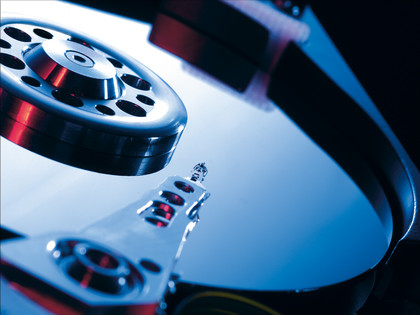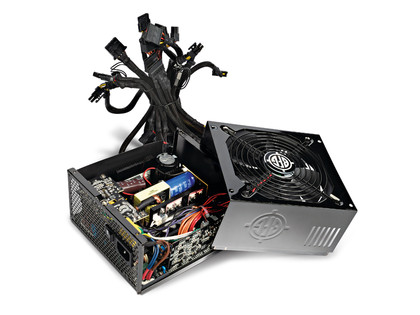There's nothing that strikes fear into the heart of a PC user more than the prospect of hard disk failure. One moment you're pottering along and the next you're in a world of pain. If you haven't yet backed up, you could be looking at the complete loss of your data, the hassle of reinstalling an OS and the tedious work of recreating precious files. Thankfully, hard disk failures aren't entirely random, and so they can sometimes be predicted.
Hard disks are mechanical devices with moving parts. Over time these parts begin to wear out and, as they do, there will be subtle changes in how the drive performs. If your drive's motor is coming to the end of its life then the drive may take longer to spin up or files may need fractionally more time to load. These changes and drop-offs in performance aren't likely to be perceptible to even the most experienced PC user.

Instead, you'll need special monitor and analysis tools to pick up on them. This is where Self-Monitoring, Analysis and Reporting Technology (SMART) comes in. It's a monitoring system for hard disks that's designed to detect and report on various indicators of reliability in the hope of anticipating failures.
All modern hard disks have SMART built in, but sadly Windows makes little or no use of it. To start delving into SMART, you'll need a third-party app – we found CrystalDiskInfo to be the best. It's a freeware app that you can download from here.
It's highly technical and isn't big on user friendliness. Indeed, its download page is difficult to understand – select the Installer Edition (EXE) version if you're stumped.
When the application is installed and running, you may need to manually select English as the language (our download defaulted to Chinese characters). Make this change by selecting 'Language' in the top right of the program's interface, then 'A-N' and finally 'English'.
When the app's up and running, you should see a breakdown of key drive statistics. Firstly, there's Health Status – if it moves away from Good, replace your drive. Temperature, Power On Count and Power On Hours are also useful.
Sign up for breaking news, reviews, opinion, top tech deals, and more.
Manufacturers publish the operational tolerances of their drives, and also Mean Time Before Failure (MTBF) figures. If your drive is approaching its MTBF, consider replacing it. If it's running close to its maximum operating temperature, think about making changes to the airflow inside your PC.
CrystalDiskInfo offers a huge amount of esoteric SMART telemetry. With a little web research you should be able to make sense of it. These figures are amalgamated into the app's basic Health Status reading, so stick with that if you're in a rush.
Many hard disk manufacturers also offer disk analysis tools tailored to their own drives. Fujitsu offers a quick testing tool that can assess a disk in three minutes, as well as a more advanced utility that can take over 100 minutes to analyse a disk. 05v 350ma
Hitachi has an excellent selection, including disk fitness testers and a SMART analysis tool. Samsung's HUTIL diagnosis and analysis tools can be found here and Seagate's SeaTools testers are here. Finally, if you're a Western Digital user, head to here. From there, you'll need to select your drive and then click 'Data Lifeguard'.
The key to these tools is using them regularly. If you're intimately acquainted with the health of your hard disk, you'll spot any problems much faster, allowing you to act pre-emptively and decamp data to a new disk if disaster is looming.
Take action: Cool your hard disk
Beyond shock, extremes of heat are a hard disk's worst enemy – so if you want your disk to have a long and healthy life, you need to keep it cool.
First, research your drive's thermal thresholds. Assuming you find your disk is running too hot, you need to take the case off your machine and begin improving the airflow around it. Start by cleaning your case's intake and exhaust fans. Next, tidy up the cables – a bird's nest of wires can strangle the airflow inside your case.
When you're happy that everything is cleaner and tidier, replace your case and give your PC a heat soak test by running a strenuous task such as a full drive defrag or a deep virus scan. Once that's finished, use your chosen drive analysis tool to check the disk's temperature.
Hopefully your efforts will have paid off, but if your drive is still running too hot, think about investing in a hard disk cooler. The Xilence Icebox Passive Hard Disk Cooler uses heatsinks and heatpipes to move heat away from your hard disk. Check it out at www.quietpc.com.
If the worst has already happened, check out our feature How to restore deleted files and recover data from damaged disks.
You might be tempted to buy the cheapest power supply with the highest wattage rating you can find in order to save money. After all, a PSU won't make your games run faster or your movies look better, so why bother forking out more than you have to? Well, take it from us: a higher-priced PSU can be worth every penny of its extra cost.
The hotter it gets inside a PSU, the less power it's able to produce. Some manufacturers take advantage of this by rating their PSUs at a much lower temperature than what they'll ever see inside a case.
For example, a unit rated for 600W at a chilly 25C might only be capable of 450W at a more realistic 40C to 50C. On top of that, you have to knock off another 100W or so if the label represents a peak power rating instead of continuous.

There are even more ways of double-dealing. Some manufacturers will skimp on their PSUs' internal components – a practice that's often associated with lower-weight units. While this helps the manufacturer to cut costs, you'll pay dearly for it through voltage fluctuations that can damage your components, cause intermittent reboots and lead to premature hard drive failure. Suddenly that bargain-basement PSU looks like a PC disaster in the making.
All this helps explain why one of the biggest pushes by power supply manufacturers of late has been to increase the efficiency of their PSUs. On the downside, this means that power supplies are more expensive than they used to be – but happily they also consume less electricity. If you're counting the pennies, think of the extra outlay an investment that will yield lower power bills.
So, how do you spot a good PSU? The key is to look for the 80 PLUS logo. This scheme is backed by a grading system that awards PSUs that are 80 per cent efficient at 20 per cent, 50 per cent and 100 per cent loads. There are Bronze, Silver, Gold and Platinum grades for more efficient PSUs as well, which are given to those devices that achieve 81, 85, 88 and 91 per cent efficiency respectively at 100 per cent loads.
The higher-efficiency models tend to be focused towards always-on servers, although hopefully we should see the same technology filter down to the mainstream market in the near future.
Knowledge is power
Probably the hardest thing about buying a PSU is knowing how much power you actually need. You could slavishly research every component inside your computer to find out their power requirements, or you could be smart.
If you fancy the latter route then you need the Extreme Power Supply Calculator. Simply enter some details about your machine and then press the 'Calculate' button. The resulting figure may strike you as a little low, so, to be safe, buy a supply that has some headroom.
The key point in your PSU research is to remember that you don't want your power supply running at a load of 100 per cent. Rather, you should be aiming for a peak load of 80 per cent. This will leave a safety margin and allow a modest upgrade in the future.
While we're on the subject of power, it's worth mentioning the uninterruptible power supply (UPS). A UPS is an emergency battery pack designed to provide your machine with power if there's an electrical blackout, thus cutting the risk of data loss or corruption. Your machine's power demands dictates the rating of the supply you should buy. See APC's UPS selector for assistance.
Current page: Hard disk and PSU failure
Prev Page Quick guide to back-ups Next Page Tools to monitor your PC